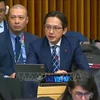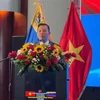Overlapping policies are hindering poverty reduction efforts, according to Minister of Labour, War Invalids and Social Affairs Pham Thi Hai Chuyen.
At a recent conference drafting the Government’s report on poverty reduction in the period of 2005-2012, delegates pointed to the fact that many ministries issued policies designed for the same purpose, resulting in stretching resources which are already limited. One example of this is a range of policies on investment in infrastructure for disadvantaged communes, including Programme 135 for disadvantaged communes of ethnic minority groups, Programme 30a for the 61 poorest districts, and the programme on building new-style rural areas.
The State and local budget cannot meet the capital demand for all projects under these programmes at the same time, resulting in delays in implementation of them all.
The large number of policies built by various ministries and agencies also makes it difficult to keep consistency. Two similarly poor households in the same commune may receive assistance at different levels depending on whether they benefit from Programme 135 or Programme 30a, leading to beneficiaries’ complaints.
Another example of the overlapping policies is the buying of medical insurance for the poor. As the policy is conducted by several ministries and agencies, it happens that a beneficiary may receive several health insurance cards, which is a waste of State money.
To counter the problem, the Ministry of Labour, War Invalids and Social Affairs (MOLISA) has proposed that all existing national target programmes for poverty reduction should be combined into a single one to prevent scattered investment. Local authorities should be given a stronger say in how to allocate investment to meet local needs, while a coordinator is needed for the implementation of policies in each specific area.
According to MoLISA’s report, the country saw an annual average poverty rate reduction of 2 percent and a 5 percent fall in disadvantaged districts and communes from 2005-2012.
In 2013, 621,000 poor households were provided with preferential loans for production development, and 13 million disadvantaged and ethnic people were granted health insurance cards.
However, the achievements were unstable, especially in mountainous and ethnic minority populated regions where the number of poor households accounts for 50 percent of the country’s total.-VNA
At a recent conference drafting the Government’s report on poverty reduction in the period of 2005-2012, delegates pointed to the fact that many ministries issued policies designed for the same purpose, resulting in stretching resources which are already limited. One example of this is a range of policies on investment in infrastructure for disadvantaged communes, including Programme 135 for disadvantaged communes of ethnic minority groups, Programme 30a for the 61 poorest districts, and the programme on building new-style rural areas.
The State and local budget cannot meet the capital demand for all projects under these programmes at the same time, resulting in delays in implementation of them all.
The large number of policies built by various ministries and agencies also makes it difficult to keep consistency. Two similarly poor households in the same commune may receive assistance at different levels depending on whether they benefit from Programme 135 or Programme 30a, leading to beneficiaries’ complaints.
Another example of the overlapping policies is the buying of medical insurance for the poor. As the policy is conducted by several ministries and agencies, it happens that a beneficiary may receive several health insurance cards, which is a waste of State money.
To counter the problem, the Ministry of Labour, War Invalids and Social Affairs (MOLISA) has proposed that all existing national target programmes for poverty reduction should be combined into a single one to prevent scattered investment. Local authorities should be given a stronger say in how to allocate investment to meet local needs, while a coordinator is needed for the implementation of policies in each specific area.
According to MoLISA’s report, the country saw an annual average poverty rate reduction of 2 percent and a 5 percent fall in disadvantaged districts and communes from 2005-2012.
In 2013, 621,000 poor households were provided with preferential loans for production development, and 13 million disadvantaged and ethnic people were granted health insurance cards.
However, the achievements were unstable, especially in mountainous and ethnic minority populated regions where the number of poor households accounts for 50 percent of the country’s total.-VNA



















